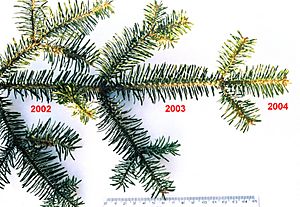Evergreen facts for kids
In botany (the study of plants), an evergreen is a plant that keeps its leaves green and working all year round. This is different from deciduous plants, which lose all their leaves during winter or a dry season. Evergreens come in many types and can live in various environments. Their unique ability to stay green makes them special!
Contents
What Kinds of Plants Are Evergreens?
Many different kinds of plants are evergreens. These include trees, shrubs, and even vines.
Some common evergreens are:
- Most conifers, like pine trees, hemlock, spruce, and fir. (But not all conifers are evergreen, for example, the larch tree loses its needles.)
- Trees like live oak and holly.
- Older types of gymnosperms, such as cycads.
- Many woody plants from places that never get frost.
- Trees found in rainforests.
- All eucalypts.
- Plants like clubmosses.
- Most types of bamboo.
The Latin word sempervirens means "always green." You might see this word in the scientific names of some evergreen plants, like:
- Cupressus sempervirens (a type of cypress tree)
- Lonicera sempervirens (a type of honeysuckle vine)
- Sequoia sempervirens (the famous redwood tree)
The leaves on evergreen plants can last for different amounts of time. Some leaves stay on the plant for a few months, while others can last for many decades! For example, the Great Basin bristlecone pine can keep its leaves for over 30 years.
Famous Evergreen Plant Families
Here are some well-known plant families that include many evergreens:
- Araucariaceae: Like the Kauri tree.
- Cupressaceae: Includes the giant Sequoia.
- Pinaceae: This family has many Pine trees.
- Podocarpaceae: Such as the Real yellowwood.
- Taxaceae: Like the Yew tree.
- Aquifoliaceae: This is the family of Holly.
- Fagaceae: Includes the Live oak.
- Rutaceae: This family gives us Citrus fruits.
- Myrtaceae: Like the Eucalyptus tree.
- Arecaceae: The family of Coconut palms.
- Lauraceae: Such as the Bay tree.
- Magnoliaceae: Includes the Southern magnolia.
- Cycadaceae: Like the Queen sago.
The Japanese umbrella pine is very special. It's the only species in its entire plant family!
How Evergreens Are Different from Deciduous Plants
Evergreen and deciduous plants have some key differences in their leaves and how they grow. Generally, evergreen plants with broad leaves have thicker leaves than deciduous plants. Their leaves also have more internal space for storing things like water and air.
Evergreens tend to have more of their total plant weight in their leaves. However, they often do not photosynthesize (make food from sunlight) as quickly as deciduous plants.
Why Plants Are Evergreen or Deciduous

Deciduous trees usually drop their leaves to help them survive very cold winters or seasons with long dry periods. Evergreen trees also lose leaves, but they do it slowly, one by one, throughout the year, instead of all at once.
Most plants in tropical rainforests are evergreens. They replace their old leaves gradually as new ones grow. In places with very distinct wet and dry seasons, plants can be either evergreen or deciduous. Many plants in warm temperate climates are also evergreen.
In very cold temperate climates, fewer plants are evergreen. This is because only a few evergreen broadleaf plants can handle very cold temperatures, usually below about -26°C (-15°F). Also, evergreen leaves can get badly damaged in cold, dry weather.
The roots of many plants are very sensitive. Even though soil helps keep roots warm, if the soil gets too cold, it can kill the plant. The exact temperature that evergreen roots can survive depends on the plant type. For example, the roots of a Picea glauca (White Spruce) can die if the temperature drops to about -23°C (-10°F).
In areas where it makes sense for trees to be deciduous (like places with cold or dry seasons), evergreen plants are often found where the soil has low nutrient levels. These evergreens usually have tough, hard leaves and are very good at saving water because resources are scarce. Evergreens are better at holding onto nutrients than deciduous trees, which lose nutrients every time they shed their leaves.
In warmer areas, some pines and cypresses grow well in poor soils or disturbed ground. Many broadleaf evergreens, like some Rhododendron species, grow in mature forests but prefer very acidic soil where nutrients are harder for plants to get. In taiga or boreal forests (cold northern forests), the organic matter in the soil decays very slowly. This means nutrients are less available to plants, which favors evergreens.
In temperate climates, evergreens can even help themselves survive! The fallen leaves and needles from evergreens make the soil more acidic and lower its nitrogen content. These conditions make it easier for more evergreens to grow and harder for deciduous plants to survive. Plus, existing evergreen plants can provide shelter, helping younger evergreen plants survive cold or dry spells.
Uses of Evergreens
Evergreen plants are used for both decoration and practical purposes. During months when most other plants are bare, evergreens are popular choices to make a landscape look beautiful with their strong structure and green leaves.
Evergreens can also act as a windbreak. If you plant them on the northwest side of a building, they can help block cold winds, which stops heat from escaping the building during winter.
See also
 In Spanish: Perennifolio para niños
In Spanish: Perennifolio para niños




